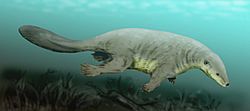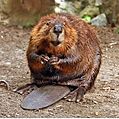Castorocauda facts for kids
Quick facts for kids CastorocaudaTemporal range: Upper Jurassic
|
|
|---|---|
 |
|
| Scientific classification | |
| Kingdom: | |
| Subphylum: | |
| Class: | |
| (unranked): | |
| Order: | |
| Family: | |
| Genus: |
Castorocauda
|
| Species | |
|
|
Castorocauda was a fascinating ancient animal that lived about 154 million years ago during the Jurassic period. It was a type of early mammal relative, meaning it was very close to being a true mammal. Scientists found its fossil in Inner Mongolia, China, in rocks that used to be a lakebed.
This amazing creature was highly specialized. It had many features similar to modern animals that live in water, like beavers, otters, and the platypus. This is called convergent evolution. It means different animals develop similar traits because they live in similar environments. Castorocauda is also the earliest animal found with clear evidence of fur.
About Castorocauda
Castorocauda belongs to a group of near-mammals called the Docodonta. Even though it wasn't a "true" mammal (a crown group mammal), it's very important for understanding how mammals evolved. Before its discovery, many scientists thought early mammal relatives were always small, lived at night, and ate insects. Castorocauda showed them something different!
Key Discoveries
Here's why Castorocauda was such an exciting find:
- Bigger than Expected: Most early mammal fossils from the Mesozoic Era were tiny. But Castorocauda was about 17 inches (43 cm) long from nose to tail. Its tail was about 5 inches (13 cm) long. It might have weighed between 500 and 800 grams.
- First Furry Find: It provided the earliest definite proof of hair and fur. Before Castorocauda, the oldest evidence of fur came from Eomaia, a true mammal that lived about 125 million years ago.
- Water-Loving Life: Castorocauda had special features for living in water. Its tail bones were flattened, much like a beaver's tail. Scientists also found traces of soft tissue between its back toes, suggesting they were webbed feet. This means it was semi-aquatic, like an otter or platypus. Before this, the earliest known water-dwelling mammal relatives were from the Eocene epoch, about 110 million years later.
- Digging Paws: Its front limbs were very strong and looked perfect for digging. This feature, along with small spurs on its ankles, makes it similar to the platypus, which also swims and digs burrows.
- Fish-Eating Teeth: The teeth of Castorocauda were shaped for eating fish. Its first two molars had pointed parts called cusps arranged in a straight line. This made them better for gripping and slicing slippery prey, rather than grinding plants. These molars were also curved backward, which helped it hold onto fish.
Images for kids
-
Docodontans likely had a sprawling gait like a platypus on land.
-
The Castorocauda tail was likely similar to that of the beaver.
-
Map of the Middle Jurassic
See also
 In Spanish: Castorocauda para niños
In Spanish: Castorocauda para niños





